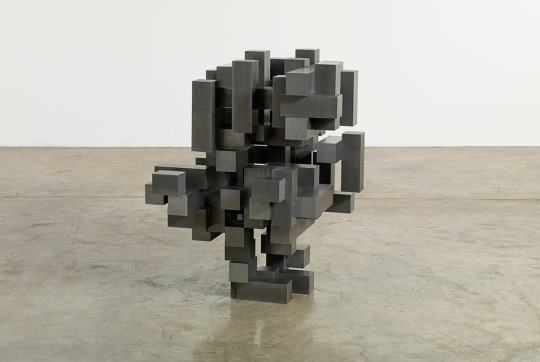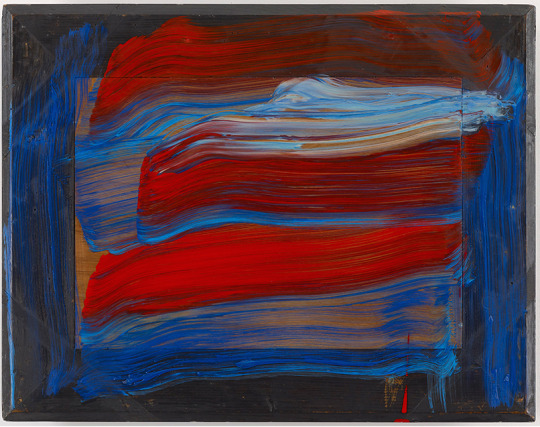Three major British artists, Antony Gormley, Tracey Emin and Howard Hodgkin have unveiled exhibitions in New York in time for Frieze week. This exemplifies just how highly regarded UK work is regarded on the other side of the pond. The work ranges in price from $200,000 to several million.

Antony Gormley, BIG FORM, 2015. Mild steel bar, © the artist. Photograph by Stephen White, London. Courtesy: Sean Kelly, New York.
Sean Kelly is exhibiting Antony Gormley’s CONSTRUCT, (until 18 June) a major one-person show of new and key early works by this London based sculptor. Gormley is internationally known for his sculptures, installations and public artworks that investigate the relationship of the human body to space, Gormley’s fifth solo exhibition with Sean Kelly engages the grid to evoke the experience of inhabiting a human body at “the other side of appearance.” The exhibition begins with a life-size work from Gormley’s series of ‘Bodycases,’ Bridge (1985), in the front gallery space. This is one of the earliest works made from a plaster mould of the artist’s body, strengthened with fiberglass and encased in a skin of lead. Gormley sees Bridge as an objective mapping of the subjective space of the human body. The visible soldering lines on its surface form clear horizontal and vertical axes: the body is treated as the location of physical and spatial experience. Bridge is presented alongside the wall relief Mother’s Pride IV (1982, remade in 2012), in which an impression of the artist’s body in the foetal position has literally been eaten out of a tightly packed grid of slices of industrially produced ‘Mother’s Pride’ white bread. Also on view alongside these works is Scaffold (2015), a recent work in which Gormley has translated the grid of horizontal and vertical lines of Bridge into a freestanding, three-dimensional mapping of the internal volumes of the body. Together these three works propose that we consider the body less as an object and more as a site and agent of transformation.

Stone Love Installation © Tracey Emin. Courtesy of Lehmann Maupin. Photos: EPW Studio/Maris Hutchinson.
Tracey Emin also has an important new exhibition at Lehmann Maupin (until 18 June). Stone Love is a solo show of new works, including painting, bronze sculptures, neon, embroidery, and works on paper. Emin’s practice is the result of an intense process of self-discovery in which she transforms her profound and personal anecdotes into universal narratives. The title of the exhibition, Stone Love, comes from the first line of David Bowie’s song Soul Love, which explores notions of romantic, physical, and familial love. Speaking about this body of work, Emin has said: “[It] is about love and the reflection of love; the desire to melt into the image of someone else, the fantasy of love. There are many different kinds of ways of loving, but as humans we are restricted to the purely physical and never have the confidence to leap into other worlds.” As in her other bodies of work, here she explores metaphysical notions of love and seeks to understand different forms of intimacy.
Though Emin has historically been regarded for her use of various media within a conceptual framework, her new body of work represents a pronounced return to painting. A modern day Expressionist continuing in the tradition of painters like Egon Schiele and Francis Bacon, Emin uncovers personal narratives in self-reflective paintings that examine both the emotional and physical states of human relationships. In creating paintings, Emin upholds the timeless legacy of figurative artworks, often modeled on her own body or on historical photographs, while developing a pictorial language and style that distinguishes her within this genre.
Emin views her bronzes as three-dimensional approaches to drawing. In emotionally and physically charged sculptures, the artist often depicts a lone, softly mottled figure. But in Stone Love, Emin also includes a sculpture of a couple as she continues to explore the frontiers of interpersonal relationships. In her neon works, which the artist regards as “missives,” she renders wistful phrases in her own handwriting. Emin, also a prolific writer, views the texts she composes for her neons as more akin to drawing, the quality of the line unique to each work. That the phrases are reproduced in Emin’s own script lends the work an urgency and sincerity. Together, the paintings, bronze sculptures, neons, embroideries, and works on paper in Stone Love frame Emin as a classical artist on a perennial journey into the self within the context of intimate and personal relationships.

Howard Hodgkin, Morning, 2015–16. © Howard Hodgkin. Courtesy the artist and Gagosian Gallery.
Gagosian Gallery is presenting “From Memory,” recent paintings by Howard Hodgkin (until 18 June). With sweeping lines of vibrant color, these works convey fleeting private moments and intense recollections. Paintings such as Morning (2015–16) and Dirty Window (2014–15) turn memories of domestic moments into experiences of pure color; while Love Song (2015) and Blues for Mrs. Chatterjee (2015) avow how words fall short of ever truly being able to describe sensations and phenomena. Completed between 2014 and 2016, Hodgkin’s paintings create pockets of time and silence, demonstrating afresh the expressiveness, the mystery, and the seeming simplicity of his art. With a deep and vivid palette and dynamic interchanges of light and dark, these paintings—always executed in oil on wooden panels—collapse the usual binary distinctions between abstraction and representation, narrative and pure sensation, past and present. Hodgkin’s images are intimate, thoughtful, and ultimately indescribable, yet they suggest great arcs of time and thought.
Photos: Top: Antony Gormley, BIG YIELD, 2015. Photograph by Stephen White, London © the artist. Courtesy: Sean Kelly, New York. Kneeling for you, 2015 (detail) © Tracey Emin. All rights reserved, DACS 2016. Courtesy of Lehmann Maupin.Howard Hodgkin, Love Song, 2015 (detail). © Howard Hodgkin. Courtesy the artist and Gagosian Gallery.

